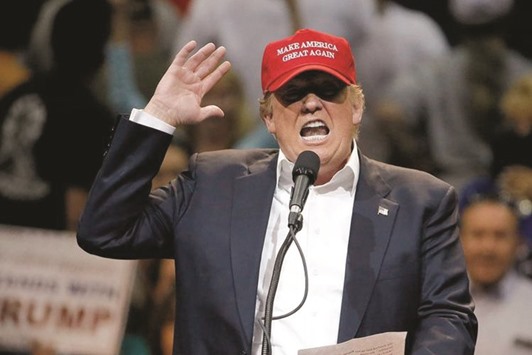During his campaign, US president-elect Donald Trump used foreign trade as a lightning rod in his supposed defence of the beleaguered American middle class. This is not an uncommon tactic for candidates at either end of the political spectrum. What is unusual is that Trump has not moderated his anti-trade tone since winning. Instead, he has upped the ante and fired a series of early warning shots in what could turn into a full-blown global trade war, with disastrous consequences for the United States and the rest of the world.
Consider Trump’s key personnel decisions. Industrialist Wilbur Ross, the Commerce Secretary-designate, has been vocal in his desire to abrogate America’s “dumb” trade deals. Peter Navarro, an economics professor at the University of California at Irvine, will be the director of the National Trade Council – a new White House policy shop to be set up on a par with the National Security Council and the National Economic Council. Navarro is one of America’s most extreme China hawks. The titles of his two most recent books – Death by China (2011) and Crouching Tiger: What China’s Militarism Means for the World (2015) – speak volumes about his tabloid-level biases.
Ross and Navarro were also co-authors of an economic-policy position paper published on the Trump campaign website that stretched any semblance of credibility. Now they will get the opportunity to put their ideas into practice. And, in fact, the process has already begun.
Trump has made it clear that he will immediately withdraw the US from the Trans-Pacific Partnership (TPP) – in keeping with Ross’s criticism of America’s trade deals. And his brazen willingness to challenge the 40-year-old “One China” policy by speaking directly with Taiwanese President Tsai Ing-wen – to say nothing of his subsequent anti-China tweets – leaves little doubt that his administration will follow Navarro’s prescription and take dead aim at America’s largest and most powerful trading partner.
Of course, Trump, a self-proclaimed master dealmaker, may simply be talking tough, in order to put China and the world on notice that the US is now prepared to operate from a position of strength in the foreign-trade arena. A bold opening gambit, the argument goes, softens the adversary for a more palatable endgame.
But, while such tough talk undoubtedly played well with voters, it fails a key reality check: America’s large trade deficit – a visible manifestation of its low saving – calls into question the very notion of economic strength. A significant domestic saving deficit, such as that which afflicts the US, accounts for America’s insatiable appetite for surplus saving from abroad, which in turn spawns its chronic current-account deficit and a massive trade deficit.
Dealmakers who try to address this macroeconomic problem one country at a time cannot possibly succeed: the US ran trade deficits with 101 countries in 2015. There can be no bilateral fix for a multilateral problem. It’s like the proverbial Dutch boy sticking his finger in a leaky dike. Unless the source of the problem – a saving shortfall that is likely to worsen in the face of Trump’s inevitable widening of federal budget deficits –is addressed, America’s current-account and trade deficits will only widen. Squeezing China would merely shift the trade imbalance to other countries – most likely to higher-cost producers, which would effectively raise the prices of foreign goods sold to hard-pressed American families.
But the story doesn’t end there. The Trump administration is playing with live ammunition, implying profound, global repercussions. Nowhere is this more evident than in the likely Chinese response to America’s new muscle-flexing. The Trump team is dismissive of China’s reaction to its threats – believing that the US has nothing to lose and everything to gain.
Alas, that may not be the case. Like it or not, America and China are locked in a codependent economic relationship. Yes, China depends on US demand for its exports, but the US also depends on China: the Chinese own over $1.5tn in US Treasury securities and other US dollar-based assets. Moreover, China is America’s third-largest export market (after Canada and Mexico) and the one that is expanding most rapidly – hardly inconsequential for a growth-starved US economy. It is foolish to think that America holds all the cards in this bilateral economic relationship.
Codependency is a very reactive connection. If one partner changes the terms of engagement, the other is likely to respond in kind. If the US goes after China – as Trump, Navarro, and Ross have long advocated and now seem to be doing – it must also face the consequences. On the economic front, that spells the possibility of reciprocal tariffs on US exports to China, as well as potential ramifications for Chinese purchases of Treasuries. And other countries – tightly linked to China through global supply chains – may well impose countervailing tariffs of their own.
Global trade wars are rare. But, like military conflicts, they often start with accidental skirmishes or misunderstandings. More than 85 years ago, US Senator Reed Smoot and Representative Willis Hawley fired the first shot in sponsoring the Tariff Act of 1930. That led to a catastrophic global trade war, which many believe turned a serious recession into the Great Depression.
It is the height of folly to ignore the lessons of history. For today’s saving-short, deficit-prone US economy, it will take far more than China-bashing to make America great again. Turning trade into a weapon of mass economic destruction could be a policy blunder of epic proportions. - Project Syndicate
*Stephen S Roach, a faculty member at Yale University and former Chairman of Morgan Stanley Asia, is the author of Unbalanced: The Codependency of America and China.

Since winning, president-elect Trump has upped the ante and fired a series of early warning shots in what could turn into a full-blown global trade war.
